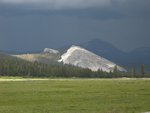Date: November 20, 2009
Contact: Shannan Marcak, 928-638-7958
Grand Canyon, Ariz. – The National Park Service (NPS) will be making operational changes to the backcountry permitting system and placing a moratorium on the number of commercial use authorizations (CUAs) issued for guided backpacking services in Grand Canyon National Park. These changes will not affect overall levels of backcountry use or the number of backcountry permits issued by the park’s Backcountry Information Center (BIC).
In order to camp anywhere in Grand Canyon National Park (other than the developed campgrounds located on the North and South Rims), a permit must be obtained from the park’s BIC. These permits are most often obtained in advance by submitting a request either in writing or in person. Regardless of how they are submitted, requests are currently accepted no earlier than the first day of the month four months prior to the start date of the trip.
Currently
| Trip Starts in this Month | First Day to Submit in Writing | First Day to Submit in Person |
| April 2010 | December 1, 2009 | December 1, 2009 |
| May 2010 | January 1, 2010 | January 1, 2010 |
Currently, all requests submitted in person receive immediate consideration. However, consideration of written requests can take up to three weeks due to the large number of requests received in writing, especially on the first day of the fourth-month-out. Many of the park’s visitors travel from across the country and around the world to take a backcountry trip and are unable to submit their advance permit requests in person. The current procedure puts these visitors at a disadvantage when requesting popular sites.
In addition, the number of people coming to the BIC to make in-person backcountry permit requests on the earliest day possible (the first day of the fourth-month-out) has been steadily growing, increasing the disparity for those who cannot apply in person and resulting in long lines and the need for additional personnel to manage the growing numbers of people.
In order to address these concerns and to streamline the permitting process in anticipation of the future addition of an online permitting system, Grand Canyon National Park will consider only written requests during the fourth-month-out starting February 1, 2010. Written requests may be submitted by fax, by letter or by hand delivery as before. Regardless of how they are submitted, written requests are considered based on the date on which they are received, and all of the requests received by 5:00 p.m. on the first day of the fourth-month-out will be placed in random order by computer and considered in that new order before the next day’s requests receive consideration.
This procedural change will mean that advance backcountry permit requestors will no longer be able to walk in and have their requests receive immediate consideration during the fourth-month-out (the earliest month permits are available.) Instead, the request will be added to the written requests received on that day. Permit requests made in person one, two and three months prior to start-of-trip will continue to be considered immediately.
Beginning February 1, 2010
| Trip Starts in this Month | First Day to Submit in Writing | First Day to Submit in Person |
| June 2010 | February 1, 2010 | March 1, 2010 |
| July 2010 | March 1, 2010 | April 1, 2010 |
Potential backcountry users are reminded that permit requests are not accepted by telephone or by e-mail. However, it is expected that in the future, it will be possible to submit backcountry permit requests online. These online requests will be included with written requests in the consideration process outlined above.
In addition to this operational change to the backcountry permitting system, a moratorium has been placed on the number of CUAs issued for guided backpacking services. This moratorium has been put into effect until park managers can better understand and adapt to growing demand for CUAs.
Over the next few years, the park expects to continue the process of developing an updated Backcountry Management Plan (BMP) which will address, among other things, commercial use in the backcountry. The BMP planning process will include periods of public comment during which the NPS will seek to learn more about public demand for, and the impact of, commercially guided backpacking. This moratorium will remain in effect until the BMP is completed.
For additional information on the backcountry permitting process, please visit the park’s web site at http://www.nps.gov/grca/planyourvisit/backcountry-permit.htm . Questions about backcountry permits may be e-mailed to grca_bic@nps.gov or sent to Backcountry Information Center, Grand Canyon National Park, P.O. Box 129, Grand Canyon, AZ 86023. You may also call the Backcountry Information Center at 928-638-7875 between 1 p.m. and 5 p.m., Monday through Friday, except on federal holidays.
If you have additional questions regarding CUAs, please contact Molly Schroer, Concessions Management Specialist, at 928-638-7707.



